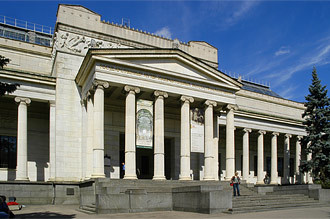The Pushkin Museum
The State Pushkin Museum of Visual Art
Posted on July 18, 2016

The museum's greatest treasures are to be found in its collection of European art from 1600, particularly the perennially popular and vastly comprehensive collection of French impressionists and post-impressionists, which comes close to that of the Musee d'Orsay in scope. Also of note are the display of Schliemann's "Troy treasure", removed from Berlin at the end of the war and probably dating from the late Bronze Age; a small collection from ancient Egypt; and rooms full of plaster casts of the most important sculptures from the Hellenistic era until the Renaissance.
While the museum lacks some of the contemporary gloss of its Western counterparts - there is no guide book at present, even in Russian, many of the exhibits appear never to have been cleaned, and the lighting and decor are old-fashioned to say the least - there is more than enough substance in the huge collection to make up for any superficial inadequacies. Underfunding and resistance to change also mean that, while a little shabby, the Pushkin is a considerably more peaceful place to contemplate great art than many of the more hyped and hectic big galleries in the West.
The museum is constantly altering its permanent display, which gives the public the chance to see more of the enormous collection, but can also be a little frustrating if you are coming to see a particular picture that has been inexplicably moved. There are also regularly changing temporary exhibitions, which often include collections from abroad. And, next to the main building, at Volkhonka 14, there is the Museum of Private Collections, purpose-built and opened in 1994, and housing mostly Russian art of the late 19th and early 20th centuries.
Opening hours: Tuesday to Sunday - 10:00 to 18:00, closed on Mondays.
SHORT HISTORY
The glorious building that houses the museum, decorated with ionic columns that are directly copied from the Erechtheion on the Acropolis, was built between 1898 and 1912 by architect Roman Klein on a site formerly occupied by a transit prison - the land was given to Moscow University especially for the construction of a museum of fine art. The museum was officially opened on 31 May 1912 as part of the centenary celebrations of Napoleon's defeat, with Tsar Nikolai II himself in attendance.
The founder and first Director of the Museum was Ivan Tsvetaev, a professor at Moscow University and father of the great poet and essayist Marina Tsvetaeva. It was almost solely thanks to his tireless efforts that the Museum came to play such an important role in Russian culture. Not only did he sink what money he had into the project, he fought long and hard for government funding and, most significantly, persuaded the great patron and industrialist Iurii Nechaev-Mal'tsev to provide on-going financial support to the Museum
After the Bolshevik Revolution the Museum obtained the collection of the Rumantsevskii Museum, as well as several 'nationalised' private collections and many works from the Hermitage. In 1932 it officially became known as the State Museum of Fine Art, and five years later Pushkin's name was added to the title in honour of the centenary anniversary of the poet's death.
Post a comment...
All recent posts and archives...




